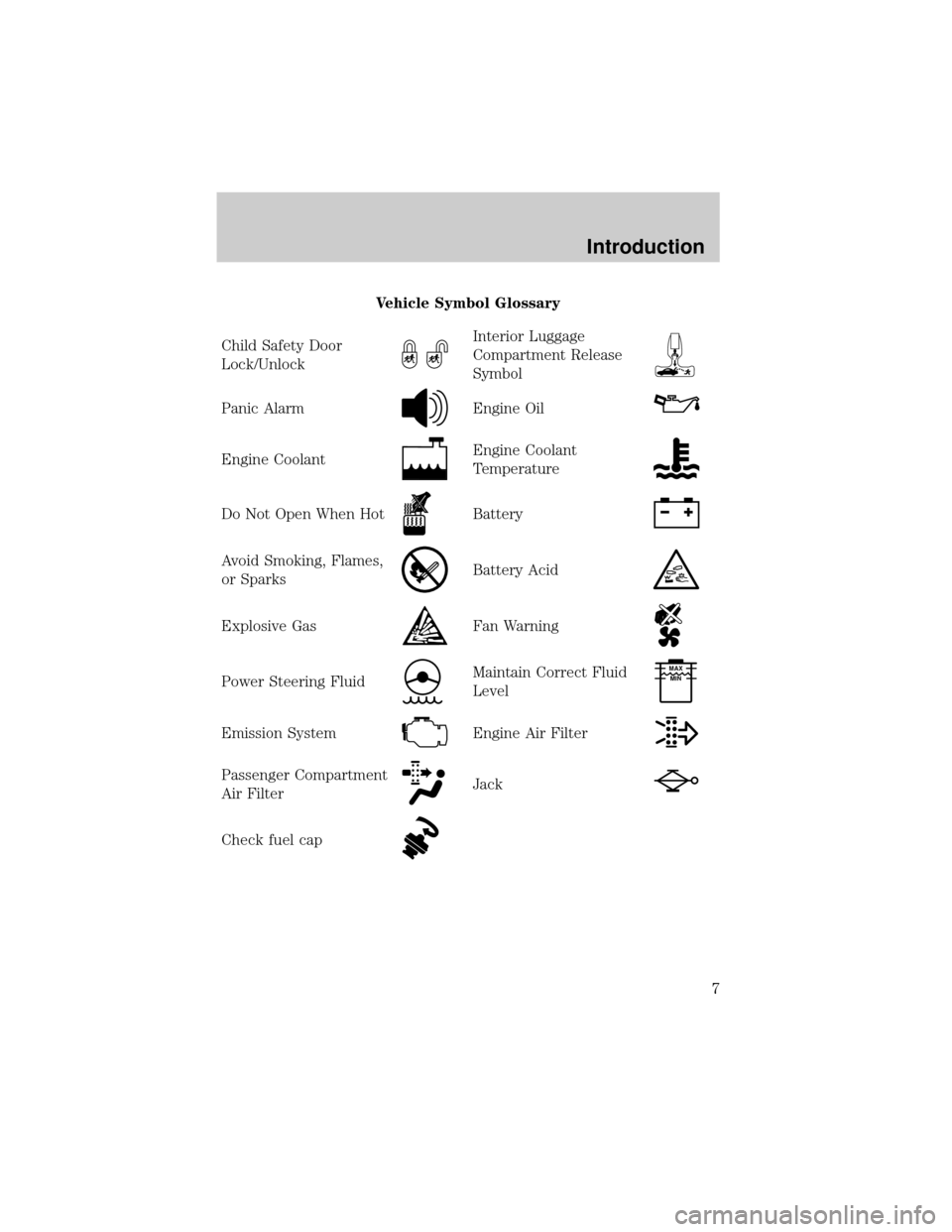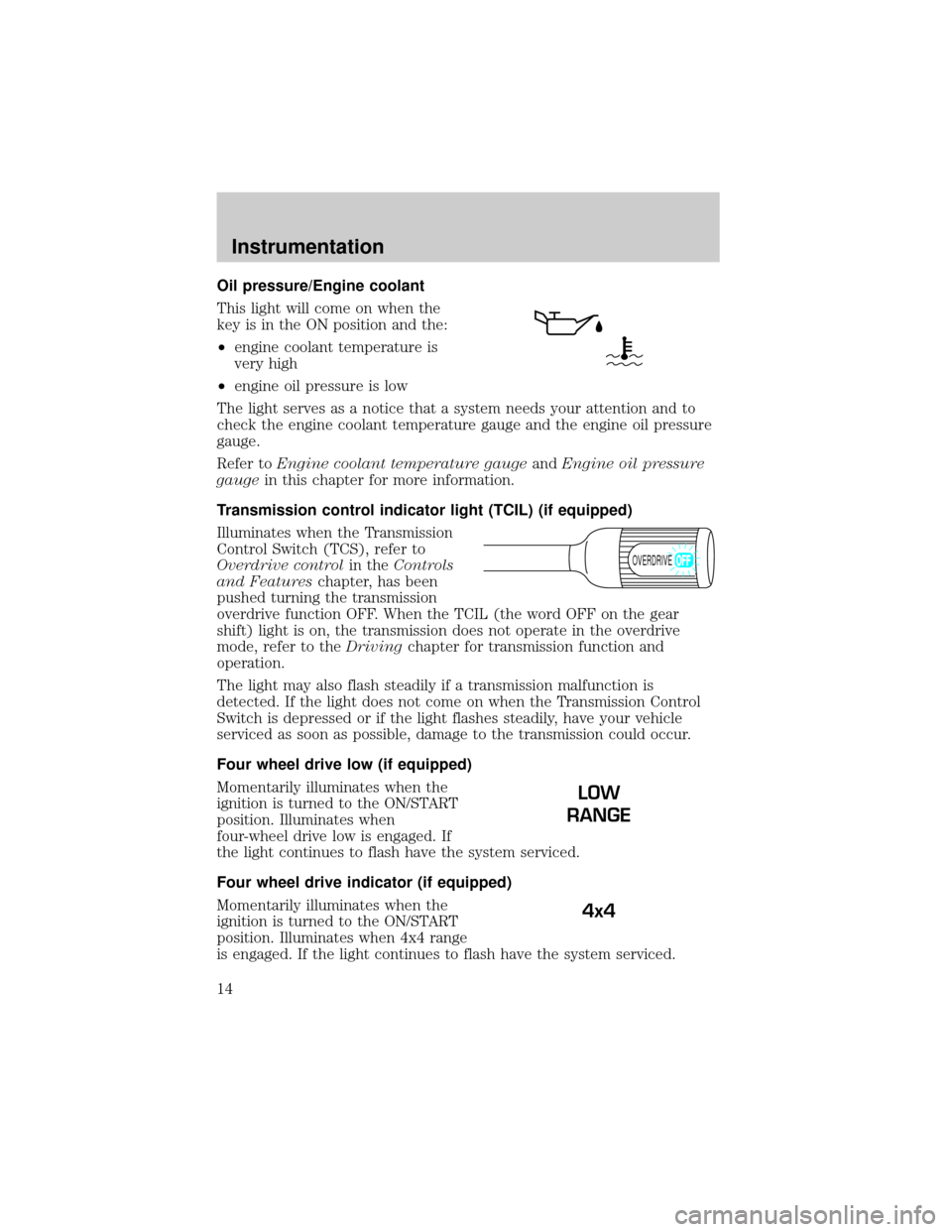2000 FORD F150 oil temperature
[x] Cancel search: oil temperaturePage 7 of 280

Vehicle Symbol Glossary
Child Safety Door
Lock/Unlock
Interior Luggage
Compartment Release
Symbol
Panic AlarmEngine Oil
Engine CoolantEngine Coolant
Temperature
Do Not Open When HotBattery
Avoid Smoking, Flames,
or SparksBattery Acid
Explosive GasFan Warning
Power Steering FluidMaintain Correct Fluid
LevelMAX
MIN
Emission SystemEngine Air Filter
Passenger Compartment
Air FilterJack
Check fuel cap
Introduction
7
Page 14 of 280

Oil pressure/Engine coolant
This light will come on when the
key is in the ON position and the:
²engine coolant temperature is
very high
²engine oil pressure is low
The light serves as a notice that a system needs your attention and to
check the engine coolant temperature gauge and the engine oil pressure
gauge.
Refer toEngine coolant temperature gaugeandEngine oil pressure
gaugein this chapter for more information.
Transmission control indicator light (TCIL) (if equipped)
Illuminates when the Transmission
Control Switch (TCS), refer to
Overdrive controlin theControls
and Featureschapter, has been
pushed turning the transmission
overdrive function OFF. When the TCIL (the word OFF on the gear
shift) light is on, the transmission does not operate in the overdrive
mode, refer to theDrivingchapter for transmission function and
operation.
The light may also flash steadily if a transmission malfunction is
detected. If the light does not come on when the Transmission Control
Switch is depressed or if the light flashes steadily, have your vehicle
serviced as soon as possible, damage to the transmission could occur.
Four wheel drive low (if equipped)
Momentarily illuminates when the
ignition is turned to the ON/START
position. Illuminates when
four-wheel drive low is engaged. If
the light continues to flash have the system serviced.
Four wheel drive indicator (if equipped)
Momentarily illuminates when the
ignition is turned to the ON/START
position. Illuminates when 4x4 range
is engaged. If the light continues to flash have the system serviced.
OVERDRIVE
LOW
RANGE
4x4
Instrumentation
14
Page 17 of 280

Speedometer
Indicates the current vehicle speed.
Engine coolant temperature gauge
Indicates the temperature of the
engine coolant. At normal operating
temperature, the needle remains
within the normal area (the area
between the ªHº and ªCº). If it
enters the red section, the engine is
overheating. Stop the vehicle as
soon as safely possible, switch off
the engine immediately and let the
engine cool. Refer toEngine
coolantin theMaintenance and
carechapter.
Never remove the coolant reservoir cap while the engine is
running or hot.
This gauge indicates the temperature of the engine coolant, not the
coolant level. If the coolant is not at its proper level the gauge indication
will not be accurate. If the gauge enters the red section, the oil
pressure/engine coolant andCheck Engine/Service Engine Soon
indicators illuminate, refer toWhat you should know about fail-safe
coolingin theMaintenance and care chapter.
Odometer
Registers the total kilometers
(miles) of the vehicle.
0MPHkm/h
20406080
00
20
40
60
C
H
Instrumentation
17
Page 234 of 280

Maintenance
²Keep tires properly inflated and use only recommended size.
²Operating a vehicle with the wheels out of alignment will reduce fuel
economy.
²Use recommended engine oil. Refer toLubricant Specifications.
²Perform all regularly scheduled maintenance items. Follow the
recommended maintenance schedule and owner maintenance checks
found in your vehicle scheduled maintenance guide.
Conditions
²Heavily loading a vehicle or towing a trailer may reduce fuel economy
at any speed.
²Carrying unnecessary weight may reduce fuel economy (approximately
0.4 km/L [1 mpg] is lost for every 180 kg [400 lb] of weight carried).
²Adding certain accessories to your vehicle (for example bug
deflectors, rollbars/light bars, running boards, ski/luggage racks) may
reduce fuel economy.
²To maximize the fuel economy, drive with the tonneau cover installed
(if equipped).
²Using fuel blended with alcohol may lower fuel economy.
²Fuel economy may decrease with lower temperatures during the first
12±16 km (8±10 miles) of driving.
²Driving on flat terrain offers improved fuel economy as compared to
driving on hilly terrain.
²Transmissions give their best fuel economy when operated in the top
cruise gear and with steady pressure on the gas pedal.
²Four-wheel-drive operation (if equipped) is less fuel efficient than
two-wheel-drive operation.
²Close windows for high speed driving.
EPA window sticker
Every new vehicle should have the EPA window sticker. Contact your
dealer if the window sticker is not supplied with your vehicle. The EPA
window sticker should be your guide for the fuel economy comparisons
with other vehicles.
Maintenance and care
234
Page 275 of 280

check engine/
service engine soon light .........11
cleaning ...................................243
coolant .....................................206
fail-safe coolant ......................211
idle speed control ...................218
lubrication
specifications ..................251, 253
refill capacities ........................248
service points ..................199±200
starting after a collision .........176
Engine block heater .................136
Engine oil ..................................200
checking and adding ..............200
dipstick ....................................200
filter, specifications ........203, 247
recommendations ...................203
refill capacities ........................248
specifications ..................251, 253
Exhaust fumes ..........................137
F
Fail safe cooling ........................211
Floor mats ...................................81
Fluid capacities .........................248
Foglamps .....................................21
Four-Wheel
Drive vehicles ......................14, 153
control trac ...............................23
description ..............................156
driving off road .......................157
electronic shift ..................23, 156
indicator light ...................14, 154
lever operated shift ................154
preparing to drive your
vehicle .....................................143
Fuel ............................................227
calculating fuel economy .......231cap ...........................................230
capacity ...................................248
choosing the right fuel ...........229
comparisons with EPA
fuel economy estimates .........234
detergent in fuel .....................230
filling your vehicle
with fuel ..................227, 230, 232
filter, specifications ........231, 247
fuel pump shut-off switch .....176
gauge .........................................16
improving fuel economy ........231
low fuel warning light ..............10
octane rating ...................229, 253
quality ......................................229
running out of fuel .................230
safety information relating to
automotive fuels .....................227
Fuses ..................................177, 179
G
Garage door opener ....................74
Gas cap (see Fuel cap) ............230
Gas mileage
(see Fuel economy) .................231
Gauges .........................................16
battery voltage gauge ...............18
engine coolant
temperature gauge ...................17
engine oil pressure gauge ........19
fuel gauge ..................................16
odometer ...................................17
speedometer .............................17
tachometer ................................18
trip odometer ............................18
GAWR
(Gross Axle Weight Rating) .....160
calculating ...............................162
definition .................................160
Index
275